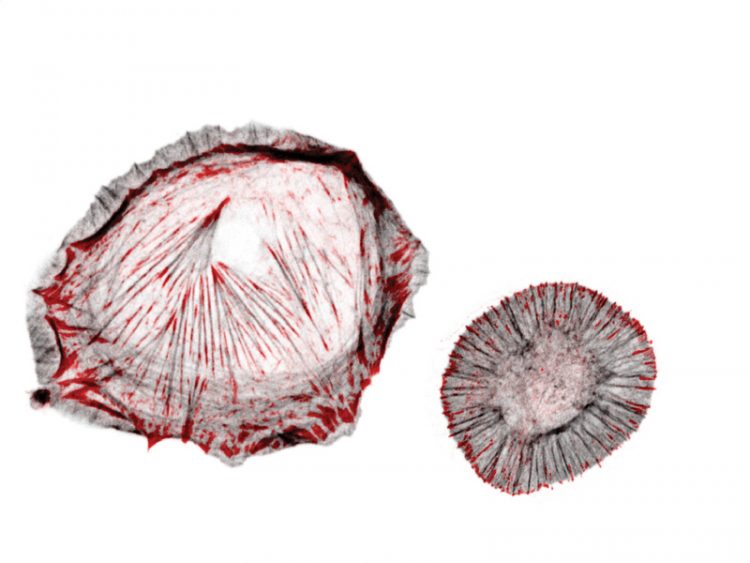New force sensing method reveals how cells sense tissue stiffness

The cell adhesion protein talin (shown in red) bears mechanical forces of seven to ten piconewton und mediates the engagement of cell adhesions to the actin cytoskeleton (shown in grey). This talin linkage allows cells to sense the stiffness of their environment so that cell adhesions become reinforced on stiff substrates (left cell). Impairing the mechanical talin linkage leads to a loss of cellular rigidity sensing (right cell). © MPI of Biochemistry/Carsten Grashoff
Just as we can feel whether we are lying on a soft blanket or hard rocks, our cells sense whether they are in a soft or rigid mechanical environment. However, the molecular mechanisms underlying cells’ ability to detect tissue stiffness are largely unknown.
Mechanical forces acting across individual molecules in cells are extremely small and cannot be measured by conventional methods. Scientists of the Max Planck Institute of Biochemistry in Martinsried have now developed a new technique to quantify forces of only a few piconewton in cells.
As a result, the researchers were able to identify the central mechanism that allows cells to sense the rigidity of their environment.
To measure the exerted molecular forces, Carsten Grashoff and his team have engineered two novel fluorescent biosensors that change their color in response to piconewton forces. Genetic insertion of these biosensors into the protein of interest allows the microscopic evaluation of molecular tension in living cells.
About five years ago, Grashoff presented the first tension sensor prototype, which has been used in many laboratories worldwide, but he is confident that the new technique will be applied by many research teams as well. “The new probes enable us to resolve differences in mechanical tension with much higher precision,” said study leader Grashoff.
By applying the method to the cell adhesion protein talin, the researchers at the Max Planck Institute discovered the central mechanism that allows cells to feel their mechanical environment. “Talin carries mechanical force of about seven to ten piconewton during cell adhesion,” Grashoff explained.
“We expected that talin is involved in the force sensing process but we had no idea how important it really is. Cells in which talin is not able to form mechanical linkages can no longer distinguish whether they are on a rigid or a soft surface.”
The researchers also found that a second talin protein, called talin-2, can be used by cells to adapt to very soft environments. Since talins are present in all cells of our body, the researchers believe that they have found a general mechanism cells use to measure the extracellular rigidity.
Contact
Dr. Christiane Menzfeld
Max Planck Institute of Biochemistry, Martinsried
Phone: +49 89 8578-2824
Fax: +49 89 8578-3777
Email: menzfeld@biochem.mpg.de
Dr. Carsten Grashoff
Max Planck Institute of Biochemistry, Martinsried
Phone: +49 89 8578-2416
Email: cgrasho@biochem.mpg.de
Original publication
K. Austen, P. Ringer, A. Mehlich, A. Chrostek-Grashoff, C. Kluger, C. Klingner, B. Sabass, R. Zent, M. Rief, C. Grashoff
Extracellular rigidity sensing by talin isoform-specific mechanical linkages.
Nature Cell Biology, November 2015 DOI: 10.1038/ncb3268
Media Contact
More Information:
https://www.mpg.de/9724830/talin-cell-forcesAll latest news from the category: Life Sciences and Chemistry
Articles and reports from the Life Sciences and chemistry area deal with applied and basic research into modern biology, chemistry and human medicine.
Valuable information can be found on a range of life sciences fields including bacteriology, biochemistry, bionics, bioinformatics, biophysics, biotechnology, genetics, geobotany, human biology, marine biology, microbiology, molecular biology, cellular biology, zoology, bioinorganic chemistry, microchemistry and environmental chemistry.
Newest articles

Webb captures top of iconic horsehead nebula in unprecedented detail
NASA’s James Webb Space Telescope has captured the sharpest infrared images to date of a zoomed-in portion of one of the most distinctive objects in our skies, the Horsehead Nebula….

Cost-effective, high-capacity, and cyclable lithium-ion battery cathodes
Charge-recharge cycling of lithium-superrich iron oxide, a cost-effective and high-capacity cathode for new-generation lithium-ion batteries, can be greatly improved by doping with readily available mineral elements. The energy capacity and…

Novel genetic plant regeneration approach
…without the application of phytohormones. Researchers develop a novel plant regeneration approach by modulating the expression of genes that control plant cell differentiation. For ages now, plants have been the…





















